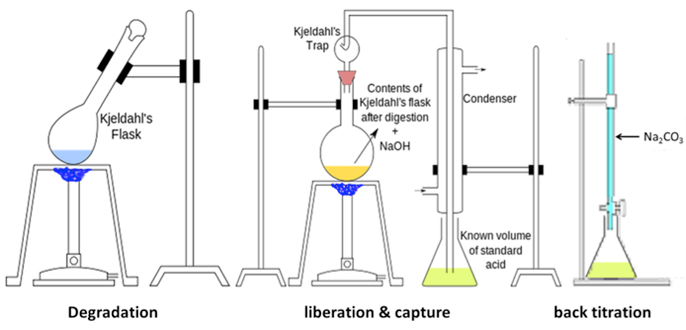What is semi-micro Kjeldahl method?
Nitrogen determination has a long history in the area of analytical chemistry. Johan Kjeldahl first introduced the Kjeldahl nitrogen method in 1883.[1] The Kjeldahl method is a technique for the quantitative determination of nitrogen content in organic substances. Although the technique and apparatus have been altered considerably over the past 100 years, the basic principles introduced by Johan Kjeldahl are still suitable today. Generally, Kjeldahl method can be divided into macro, semi-micro and micro kjeldahl method according to sample volume. The major factor influencing the selection of different types to determine organic nitrogen is its concentration. The macro-kjeldahl method is applicable for samples containing either low or high concentrations of organic nitrogen but requires a relatively large sample volume for low concentration. In the semi-micro-kjeldahl method, which is applicable to samples containing high concentrations of organic nitrogen, the sample volume should be chosen to contain organic plus ammonia nitrogen in the range of 0.2 to 2 mg.
How to perform Semi-micro Kjeldahl method?
The method consists of degradation, liberation & capture of ammonia and back titration. First, the samples are heating with sulphuric acid. Then they release the reduced nitrogen as ammonium sulphate by oxidation. During this process potassium sulphate is usually added to increase the boiling point of the medium. Decomposition of the sample is complete when the initially dark-coloured medium has become colourless. The solution is then distilled with a small quantity of sodium hydroxide converting the ammonium salt to ammonia. The amount of ammonia present is determined by back titration. The ammonia reacts with the acid and the remainder of the acid is then titrated with a sodium carbonate solution by way of a methyl orange pH indicator.

What is semi-micro Kjeldahl Method used for?
This technique is a universal, precision and reproducible which made it the internationally recognized method for estimating the protein content in foods and it is the standard method. It is also used to assay nitrogen concentration of soils, waste waters, fertilizers and other materials.
[1] New method for the determination of nitrogen in organic substances. Kjeldahl, J, Zeitschrift für analytische Chemie, 1883, 22 (1).






